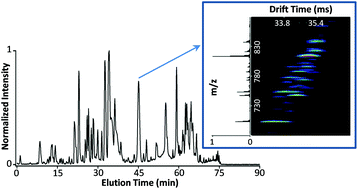Uncovering biologically significant lipid isomers with liquid chromatography, ion mobility spectrometry and mass spectrometry†
Abstract
Understanding how biological molecules are generated, metabolized and eliminated in living systems is important for interpreting processes such as immune response and disease pathology. While genomic and proteomic studies have provided vast amounts of information over the last several decades, interest in lipidomics has also grown due to improved analytical technologies revealing altered lipid metabolism in type 2 diabetes, cancer, and lipid storage disease. Mass spectrometry (MS) measurements are currently the dominant approach for characterizing the lipidome by providing detailed information on the spatial and temporal composition of lipids. However, interpreting lipids’ biological roles is challenging due to the existence of numerous structural and stereoisomers (i.e. distinct acyl chain and double-bond positions), which are often unresolvable using present approaches. Here we show that combining liquid chromatography (LC) and structurally-based ion mobility spectrometry (IMS) measurement with MS analyses distinguishes lipid isomers and allows insight into biological and disease processes.



 Please wait while we load your content...
Please wait while we load your content...